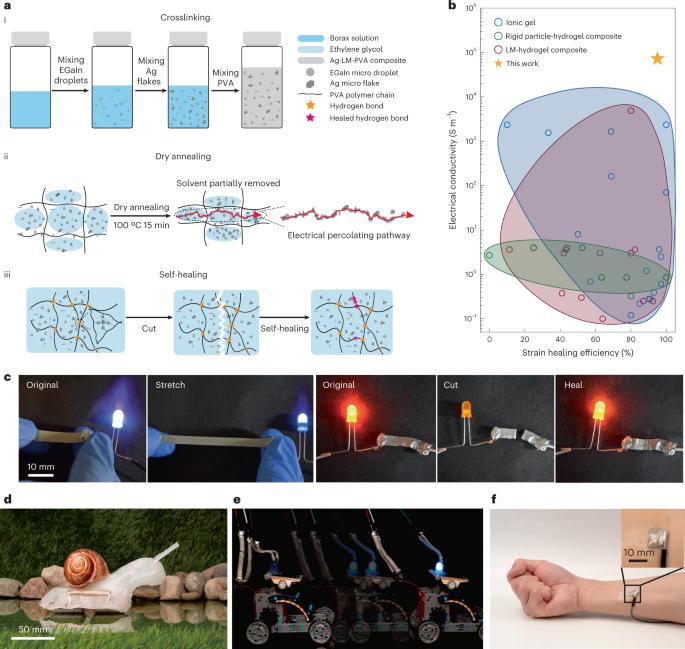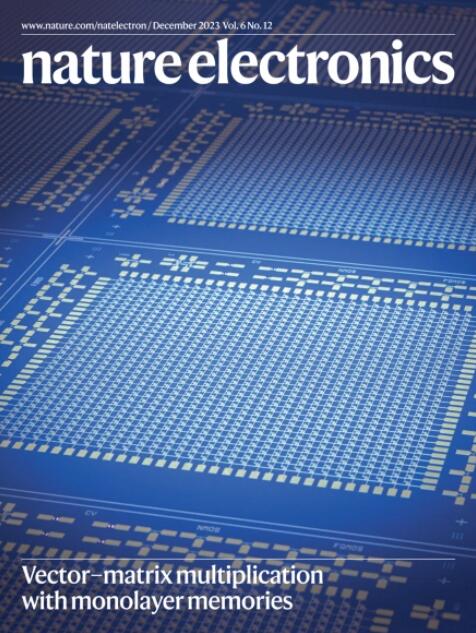A self-healing electrically conductive organogel composite
IF 40.9
1区 工程技术
Q1 ENGINEERING, ELECTRICAL & ELECTRONIC
引用次数: 24
Abstract
Self-healing hydrogels use spontaneous intermolecular forces to recover from physical damage caused by extreme strain, pressure or tearing. Such materials are of potential use in soft robotics and tissue engineering, but they have relatively low electrical conductivity, which limits their application in stretchable and mechanically robust circuits. Here we report an organogel composite that is based on poly(vinyl alcohol)–sodium borate and has high electrical conductivity (7 × 104 S m−1), low stiffness (Young’s modulus of ~20 kPa), high stretchability (strain limit of >400%) and spontaneous mechanical and electrical self-healing. The organogel matrix is embedded with silver microflakes and gallium-based liquid metal microdroplets, which form a percolating network, leading to high electrical conductivity in the material. We also overcome the rapid drying problem of the hydrogel material system by replacing water with an organic solvent (ethylene glycol), which avoids dehydration and property changes for over 24 h in an ambient environment. We illustrate the capabilities of the self-healing organogel composite by using it in a soft robot, a soft circuit and a reconfigurable bioelectrode. An organogel that is based on poly(vinyl alcohol)–sodium borate and contains a percolating conductive network of silver particles and liquid metal microdroplets exhibits spontaneous mechanical and electrical self-healing, as well as an electrical conductivity of 7 × 104 S m−1.

一种自我修复的导电有机凝胶复合材料
自愈合水凝胶利用自发的分子间作用力,从极端应变、压力或撕裂造成的物理损伤中恢复过来。这类材料在软机器人和组织工程中具有潜在用途,但它们的导电率相对较低,这限制了它们在可拉伸和机械坚固电路中的应用。在这里,我们报告了一种基于聚(乙烯醇)-硼酸钠的有机凝胶复合材料,它具有高导电性(7 × 104 S m-1)、低刚度(杨氏模量约为 20 kPa)、高拉伸性(应变极限为 400%)以及自发的机械和电气自愈性。有机凝胶基体中嵌入了银微片和镓基液态金属微滴,它们形成了一个渗透网络,从而使材料具有高导电性。我们还通过用有机溶剂(乙二醇)代替水,克服了水凝胶材料系统的快速干燥问题,从而避免了在环境中超过 24 小时的脱水和性质变化。我们将这种自愈合有机凝胶复合材料用于软机器人、软电路和可重构生物电极,以此说明它的功能。一种基于聚(乙烯醇)-硼酸钠的有机凝胶含有银颗粒和液态金属微滴组成的渗流导电网络,具有自发的机械和电气自愈合能力,其导电率达到 7 × 104 S m-1。
本文章由计算机程序翻译,如有差异,请以英文原文为准。
求助全文
约1分钟内获得全文
求助全文
来源期刊

Nature Electronics
Engineering-Electrical and Electronic Engineering
CiteScore
47.50
自引率
2.30%
发文量
159
期刊介绍:
Nature Electronics is a comprehensive journal that publishes both fundamental and applied research in the field of electronics. It encompasses a wide range of topics, including the study of new phenomena and devices, the design and construction of electronic circuits, and the practical applications of electronics. In addition, the journal explores the commercial and industrial aspects of electronics research.
The primary focus of Nature Electronics is on the development of technology and its potential impact on society. The journal incorporates the contributions of scientists, engineers, and industry professionals, offering a platform for their research findings. Moreover, Nature Electronics provides insightful commentary, thorough reviews, and analysis of the key issues that shape the field, as well as the technologies that are reshaping society.
Like all journals within the prestigious Nature brand, Nature Electronics upholds the highest standards of quality. It maintains a dedicated team of professional editors and follows a fair and rigorous peer-review process. The journal also ensures impeccable copy-editing and production, enabling swift publication. Additionally, Nature Electronics prides itself on its editorial independence, ensuring unbiased and impartial reporting.
In summary, Nature Electronics is a leading journal that publishes cutting-edge research in electronics. With its multidisciplinary approach and commitment to excellence, the journal serves as a valuable resource for scientists, engineers, and industry professionals seeking to stay at the forefront of advancements in the field.
 求助内容:
求助内容: 应助结果提醒方式:
应助结果提醒方式:


